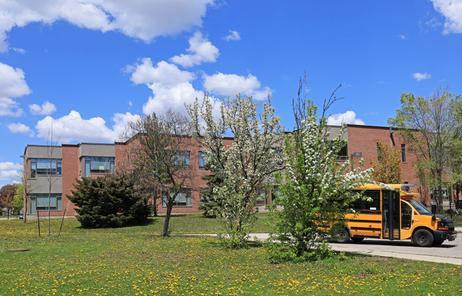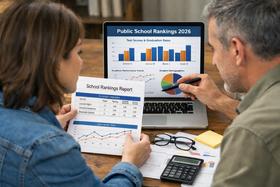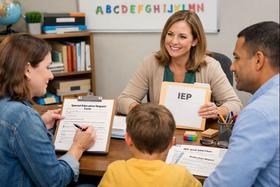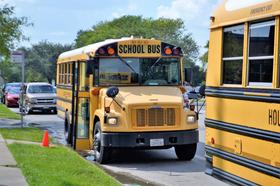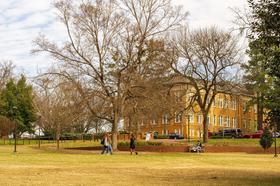History of Public Education
The first schools in colonial America were private. Public schools per se came much later on in the 19th century. A History of Public Schools offers a comprehensive overview of the subject.
Funding and Budgeting
U.S. public schools are funded by local property taxes supplemented by funding from state and private sources. 92% of public school funding comes from non-federal sources. An Overview of the Funding of Public Schools explains how the system works. Here are two examples of school district budgets to illustrate the disparity regarding funding between a large urban school district and a small rural school district.
Large School District (Example):
Total Annual Budget: $1.2 billion
Sources of Funding:
- State Funding: $700 million
- Local Property Taxes: $300 million
- Federal Grants: $150 million
- Other Sources (e.g., donations, grants): $50 million
Expenditure Breakdown:
- Instructional Costs (teachers, textbooks, supplies): $600 million
- Administrative Costs (salaries, facilities, utilities): $200 million
- Student Support Services (counseling, special education): $150 million
- Transportation: $50 million
- Building Maintenance: $50 million
- Extracurricular Activities: $30 million
- Debt Service: $20 million
- Reserves and Contingencies: $50 million
Compare this hypothetical budget with the actual 2023-24 budget of the Houston ISD.
Small School District (Example):
Total Annual Budget: $10 million
Sources of Funding:
- State Funding: $5 million
- Local Property Taxes: $3 million
- Federal Grants: $1 million
- Other Sources (e.g., donations, grants): $1 million
Expenditure Breakdown:
- Instructional Costs (teachers, textbooks, supplies): $4 million
- Administrative Costs (salaries, facilities, utilities): $1 million
- Student Support Services (counseling, special education): $500,000
- Transportation: $150,000
- Building Maintenance: $200,000
- Extracurricular Activities: $50,000
- Debt Service: $100,000
- Reserves and Contingencies: $1 million
Compare this hypothetical budget with the actual 2023-24 budget for Region 6 in Connecticut.
This TEDx Talk discusses the dilemma of funding public schools.
Curriculum and Academic Programs
The curriculum and academic programs offered in public schools vary considerably. States set the minimum requirements; however, the local school districts deliver the instruction of those requirements according to their specific needs, requirements, and capabilities. Let's look at the three education levels found in most school districts.
K-8
Here is what is taught in grades K-8 in the Greenwich, Connecticut public schools.
GPS believes that a coherent, articulated PK-12 Standards-Based Curriculum supports all learners (adults and students) in creating and engaging in high-impact learning tasks that ensure students develop and demonstrate the Vision of the Graduate capacities. Source: Greenwich Public Schools.
Middle School
The Decatur, Illinois, school district offers a detailed guide to its middle school program.
The academy model uses exposure to real-world problems to help students gain a deeper understanding of career opportunities within their chosen Academy Field. Students will have the opportunity to choose which academy they want to be in. Students will explore ways that the curriculum they are learning in their classes applies to fields open to them as career choices after schooling is completed. The academy will help students feel that they are part of a smaller community within the larger Middle School as a whole. Students will be in their core (ELA, Math, Science, and Social Studies) and Academy Exploration classes together based on their chosen academy. Students are encouraged to stay within their chosen academy for both years of middle school but will be able to apply to administration to have it changed for extreme circumstances in between 7th and 8th grade year. Source: Decatur Public Schools
High School
Here is the curriculum at the West Boca Raton Community High School in Florida.
With goals to prepare our students for intellectual and career growth in mind, this curriculum guide presents essential information in mapping out your child's high school education. The courses offered will allow each student an avenue to focus their goals and set a successful path. At West Boca Raton High School, our simple mission is that students should not only graduate from our school but they should graduate with college credit and/or an industry certification. Source: West Boca Raton Community High School
Teaching Staff
The following are some of the academic qualifications public school teachers must have in most states. Visit the state's Department of Education website for specific requirements for teachers. Essentially, public school teachers need the following three qualifications:
Bachelor's Degree
Most K-8 teachers must have a bachelor's degree in education or a related field. Some states may accept degrees in other disciplines, but teacher preparation programs are standard.
Teacher Preparation Program
Teachers also must complete a teacher preparation program accredited by the state's Department of Education. These programs provide the pedagogical training necessary for effective teaching.
Student Teaching
Practical classroom experience through student teaching or a similar internship program is often required in teacher preparation programs.
Essentially, a teacher has to know his subject and how to teach it.
Student Diversity
Student diversity varies according to the community a school district serves. For example, school districts in Montana will be at the opposite end of the diversity spectrum from school districts in major urban areas such as Detroit or Chicago.
Schools remain divided along racial, ethnic, and economic lines throughout the U.S.—even as the K-12 public school student population grows more diverse. During the 2020-21 school year, more than a third of students (about 18.5 million) attended schools where 75% or more students were of a single race or ethnicity. Source: Government Accountability Office
Extracurricular Activities
The extracurricular activities offered vary widely from district to district. They include
Sports: football, baseball, and basketball top the list of popular sports in public schools. Other sports offered include soccer, volleyball, track and field, and wrestling.
Clubs and Organizations: The limitless possibilities include debate, chess, robotics, science, drama, art, photography, and more.
Performing Arts: Public schools are renowned for their marching and concert band programs. Glee clubs and orchestras offer students other performance opportunities.
This video shows the Hebron High School Marching Band from Hebron, Texas, in action.
Student Government: Student councils and government offer the opportunity to learn how rules of order work.
Academic Competitions: Schools often participate in academic competitions such as forensics, math competitions, science fairs, and 4-H events.
Community Service and Volunteering: Public schools often encourage students to engage in community service projects or volunteer work, fostering a sense of civic responsibility.
Management
The management of the typical school district is a top-down system with the school board at the top. It, in turn, employs a superintendent to oversee the district's day-to-day operations. An experienced, credentialled staff of educational, financial, and supportive services professionals do the district's work.
Challenges and Issues
Because public schools are such a diverse constituency, they perennially face budget and philosophical issues. For example, when the demographics of a district include an older population and declining enrollment, the school board will meet demands for downsizing and reducing the budget to keep tax increases to the minimum; when a district has a significant non-English speaking population, that creates additional pressures. The 21st century has seen the politicization of many school districts. That, in turn, creates challenges for both boards and administrators.
Of course, I'd be remiss not to include the 800-pound gorilla in the room: school shootings. The possibility of a shooting in one of the schools in the district provides the backdrop for most of the activities that take place in 21st-century schools in the United States.
Read EdWeek's article The Status of the Teaching Profession..., for a gloomy assessment of the current teaching profession.
Questions? Contact us on Facebook. @publicschoolreview
#PublicSchools #EducationOverview #K12Education #SchoolDistricts #EducationalDiversity #CurriculumInsights #EducationSnapshot

